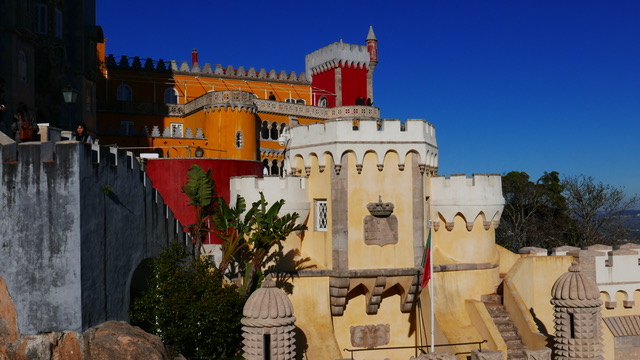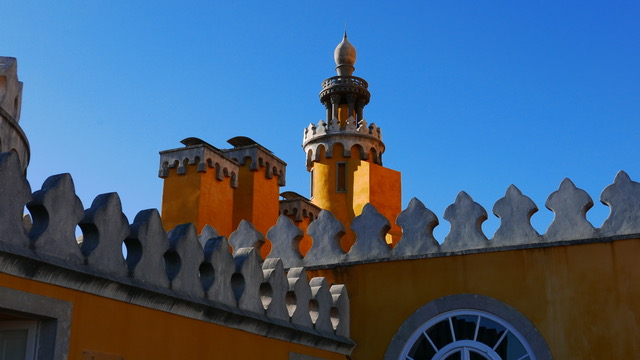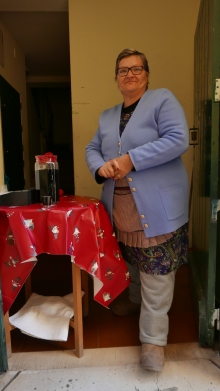
Reach for a word to pair with “Portuguese” and what do you come up with?
Until our week in Lisbon, we were pretty much stuck at “seafaring” (Vasco de Gama, etc.) and “man o war” (a jellyfish-like sea creature also known as “floating terror”).
By the end of our week, we had added another: “romantic.” Not “romantic” as in hearts and flowers (or Louis and Doris) but romantic as in a distinctive style so idealized it evokes Disneyland’s magic kingdom, except this one is real.

Some of this comes down to something called “Manueline” style, Portugal’s extravagant take on late Gothicism, which already was pretty extravagant before the Portuguese got their hands on it. Since we had never heard of Manuelism before this month, we will leave the details to Wikipedia and actual authorities. For the purposes of explaining Louis’s images, suffice it to say the style is named for King Manuel I of Portugal, and it is indigenous and unique to the country he ruled. Its architectural reign of not even 30 years barely outlasted Manuel himself (d: 1521), yet the landscape in and around Lisbon is strewn with its confections.
We did not set out to learn any of this when we began traipsing around Lisbon but Manuel’s eponymous legacy fast becomes inescapable.



In the church of the monastery, two national heroes are prominently entombed. One is native son Vasco de Gama, the first European to sail to India. The second is the Luís Vaz de Camões, a romantic poet. What country gives equal billing to its poets and its adventurers? Only a romantic one.

But the hottest bed of Portuguese romanticism on our visit was Sintra, about 15 miles and 40 minutes by cheap train from Lisbon. Sintra is the site of so much Manuelism and neo-Manuelism (a 19th-century flash to the past) that the tourist magnet is simply called “Romantic Sintra.”





Then there is nearby Quinta da Regaleira, a palace and gardens that bring adjectives like “fantastic” (as in “of fantasy”) and “fabulous” (as in “of fable”) to life.

From 1898 to 1912, the celebrated capitalist Carvalho Monteiro dedicated his life and fortune to transforming a former summer palace of aristocrats into a “mysterious iconographical programme.” When the French landscape architect he hired to design the gardens didn’t pan out, the visionary employed from the set designer from the legendarily romantic La Scalia of Milano to get the job done.
The results are … romantic! And another World Heritage site. The official guide uses words like “exuberant,” “quixotic,” “enigmatic,” “esoteric,” “magical” and “alchemical” for the orgy of structures, figures, carvings, labyrinths, tunnels and other creations that combine to make Quinta da Regaleira.


A single week and a single blog are barely enough to reflect infatuation, much less all the romance of Portugal. In the end, the decidedly unromantic magic of commercial airline flight whisked us off to the Czech Republic, trailing clouds of romantic fancy.
- Trains, planes and elevators, oh my: Lisbon has a marvelous transportation system in which one ticket card (rechargeable at any Metro station) provides access to every public conveyance the city offers: bus, cable car, tram, train, ferry, even the fee elevators. Better yet, there is a pensioner rate they extend even to visitors with proof of 65 years are more. What could top romance in Lisbon? Romance on the cheap.

Doris and the train to Sintra - Ginjinha in the alleys of Alfama: Portugal’s indigenous liqueur is ginjinha (or ginja), a concoction of alcohol infused with sour cherries, sweetened with sugar and, traditionally, served in a shot glass with a cherry at the bottom. In the winding alleys of Alfama, ladies like Dora stand in their doorways selling shots for 1€ a slug. This may not exactly be romantic but, given that a bottle sells for under 10€, it’s not a bad business model.
- Travel karma: As if wandering partout at Quinta la Regaleira were not treat enough, we managed to stumble into the palace at the moment a piano maestro and opera diva were filling the music room of the fairy-tale palace with Don Giovanni. Sublime.
 Coming soon: When in Prague
Coming soon: When in Prague

“Lo! Cintra’s glorious Eden intervenes,” quoth the romantic bard of England in 1809. Nearly 200 years later, the romance – and Lord Byron in Sintra – live on.



Romantic indeed! Thanks for the Manueline treats. Snow on the ground here and, no, we have not seen a Portuguese blue sky for a while.
LikeLike
Portuguese —— words that rhyme: 1). Lebanese 2). Gotta sneeze; 3). Pass the cheese…
Ok alright already. You’re the writer!! Loving the journal!
Us uptons
Sent from my iPhone
>
LikeLiked by 1 person
Thanks, Amey, but I’ll have to leave the rhyming to you. I could never have come up with those!
LikeLike
What a sumptuous feast for the eyes!
LikeLike
Thank you, Sharon. We aim to feed!
LikeLiked by 1 person
Dear Doris and Louis,
Just loved it!
All the best! and continue in your lovely road!
Fatima
(and the portuguese student above says “How nice!”)
LikeLike
Thank you, Fatima. We consider that high praise from a local.
Friends and followers: Fatima and some friends of hers own wonderful flats in Lisbon. Let us know if you are headed Lisboa-way, and Partout will connect you.
LikeLike
Que legal!
LikeLike
Thanks, oh Portuguese student. And what does that mean?
LikeLike
It means “Cool!” I was wondering if you’d heard it while there. But maybe it’s a Brazilian Portuguese thing…
LikeLiked by 1 person